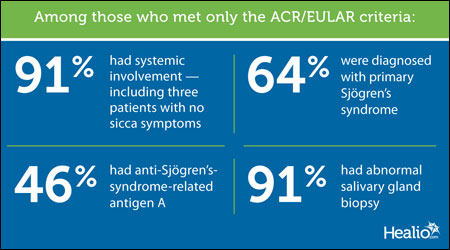AECG, ACR/EULAR Classification Criteria for Sjögren’s Syndrome in ‘Excellent’ Agreement
There is “excellent” agreement between the 2002 American-European Consensus Group and the 2016 American College of Rheumatology/European League Against Rheumatism classification criteria for primary Sjögren’s syndrome, according to findings published in Arthritis Research and Therapy.
The researchers also concluded that including salivary gland ultrasonography in the ACR/EULAR criteria may further improve their sensitivity.
“This study was important to perform in order to validate the new classification criteria that were developed last year for primary Sjögren’s patients, to ensure that the results of studies that were performed using the 2002 AECG criteria could be compared to the results of future studies that will use the 2016 ACR/EULAR criteria,” Divi Cornec, MD, PhD, of the Hôpital de la Cavale Blanche, in Brest, France, told Healio Rheumatology.
To analyze the agreement between the AECG and ACR/EULAR criteria for primary Sjögren’s syndrome, and to determine to what extent salivary gland ultrasonography could improve classification, the researchers conducted a cross-sectional study of patients at Brest University Hospital from January 2006 to September 2016. Patients with suspected primary Sjögren’s syndrome received a standard evaluation, including salivary gland ultrasonography. The researchers used Cohen’s coefficient to determine agreement between the two sets of criteria.
The researchers included 209 patients in the prospective study. Among those, 43% met the ACR/EULAR criteria, whereas 39% met both ACR/EULAR and AECG standards. In addition, 4% met only the ACR/EULAR criteria, no patients met only the AECG set and 57% met neither criteria.

According to the researchers, agreement was excellent ( = 0.92). In addition, the 4% of patients who met only the ACR/EULAR criteria had similar age and symptom duration, compared with those who fulfilled both standards. However, they had lower rates of xerophthalmia and xerostomia (P<0.01 for each) and salivary gland dysfunction (P<0.01). Among those who met only the ACR/EULAR criteria, 91% had systemic involvement — including three patients with no sicca symptoms — 91% had abnormal salivary gland biopsy, 46% had anti-Sjögren's-syndrome-related antigen A, and 64% were diagnosed with primary Sjögren’s syndrome.
The researchers also found that salivary gland ultrasonography was abnormal in 12% of patients who met neither criteria set. Including the ultrasonography in the ACR/EULAR criteria increased the standard’s sensitivity from 87.4% to 91.1%.
“We found, in our large monocentric cohort of patients with suspected primary Sjögren’s syndrome, that the agreement between the two criteria sets is excellent, and that the new 2016 criteria are slightly more sensitive to classify the disease, especially in patients with prominent systemic features,” Cornec said. “Therefore, these new criteria are a step toward a better classification of the patients and should be used in all future clinical studies.”
Cornec added, “Furthermore, we evaluated the added value of salivary gland ultrasonography to classify the patients, and we suggest that this non-invasive, largely available, and easy-to-perform test should be included into future classification criteria for the disease.”– by Jason Laday
Disclosure: The researchers report no relevant financial disclosures.
